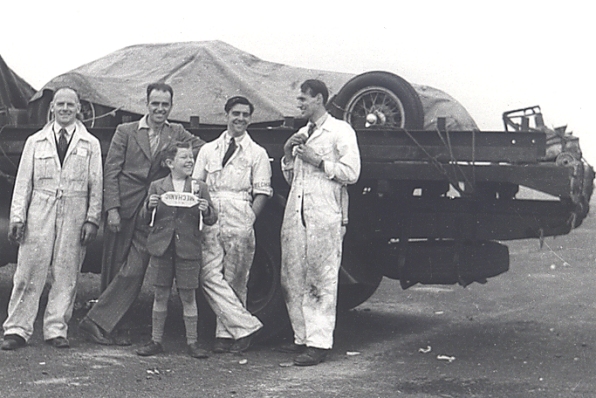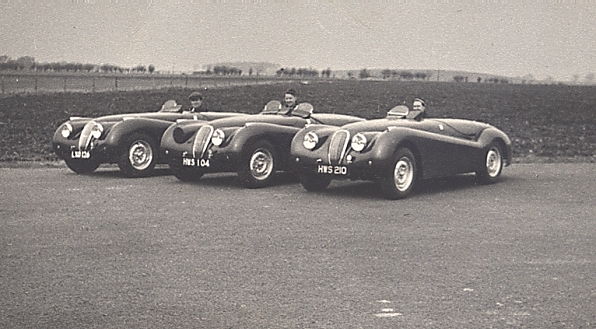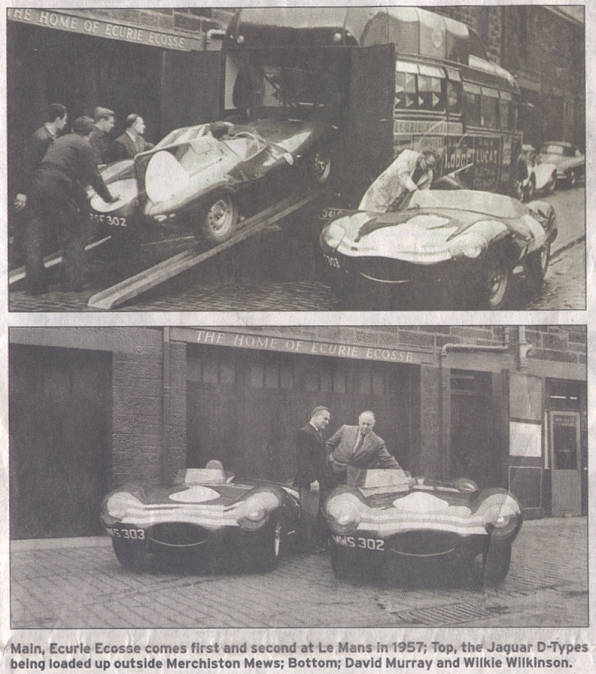|
It was long ago, in a golden age of
motorsport, when gentlemen drivers roared around snaking S-bends with
breathtaking precision wearing their sensible sweaters and leather trimmed
goggles, relentlessly pushing their cars to speeds never achieved before.
Tucked behind the wheel of some of
the most elegant and exciting sports cars ever made, these pioneers of
motor sport pressed hard on the accelerator and paved a trail for
legendary names to come; drivers and theft teams who have gone down in the
pages of racing history.
Names like Ferrari and Maserati,
Jaguar and Aston Martin and, the most rarefied of them all, Ecurie Ecosse.
Its headquarters, a pokey garage
tucked away in a cobbled mews in the heart of Edinburgh, is a million
miles away from the glitz, glamour and financial excesses we may have come
to expect from the modem world of motor sport. Yet it was from that very
back street exactly 50 years ago that a racing enthusiast with more
romantic spirit than money lived out his remarkable dream—
and created a racing team whose star burned briefly but brightly, and
become legendary despite its undignified demise.
Today, the name of the team
founded by the charismatic and enigmatic David Murray, Ecurie Ecosse - a
title much more glamorous and exotic than Team Scotland could ever have been - justifiably lives
on in motor sport history. Indeed, its very mention still fills fans with
a nostalgic yearning for an era when the glamorous, dangerous and
thrilling sport was still in its infancy; when the sleek lines of the
D-type Jaguar graced the race track and those drivers celebrated
astonishing victories with a cup of tea and a nap.
Who could fail to be intrigued by
the roller coaster story of how a racing team run on a shoestring budget
from a Scottish back-street garage could possibly take on - and emphatically trounce - some of the
biggest names in the world of motor racing, twice winning one of the most
prestigious and gruelling of races: the Le Mans 24-hour endurance classic.
These were sensational victories:
who could have suspected that a tiny team of such limited resources could
accumulate such an astonishing combination of talent to beat the best in
the world, not once, but twice?
None of it might never have happened
had Mr Murray, a chartered accountant, wine merchant, pub owner and motor
sport enthusiast, not dramatically crashed out of a practice run at the
Nurburgring just before he was due to race in the 1950 German Grand Prix.
His own driving ambitions shattered,
he decided to concentrate his efforts - and spare cash - on joining forces with a
Cockney mechanic; Wilkie Wilkonson, who would provide the technical
wizzardry which would enable Ecurie Ecosse to beat the best, despite not even having any cars of
their own to race.
Murray’s humble car repair business
in Merchiston Mews became the team’s unlikely headquarters. Merchiston
Motors was just like any other motor garage business, unremarkable apart
from the fact that somehow it managed to gather together the best
mechanics and most talented drivers the country has every produced, at
exactly the right time.
Wendy Jones, Mr Murray’s secretary
at the time, clearly remembers the excitement. "It was impossible not to
be caught up in it all," she says.
From garage owner’s secretary, she
found herself helping to drive the distinctive D-type Jaguars from race to
race, cooking up snacks for the team and running errands - often jumping behind the wheel herself to
nip into the villages around Le Mans for urgent supplies.
"It’s remarkable to think that such
a small team could achieve what it did," she reflects. "They took on the
greats and beat them because of incredible teamwork and talent."
In just ten seasons, Ecurie Ecosse
notched up some 68 victories, the most amazing of which were the two Le
Mans titles which sent shockwaves through the world of sport even though,
initially, the team did not even have any its own cars on show.

Left to Right: Billy Wells (foreman Merchiston Motors),
Sandy Arthur, local boy, George (mechanic Merchiston Motors), Ron (Ranald)
McIntyre (mechanic Merchiston Motors). Pre Ecurie Ecosse formation.
Vehicle is a Maserati 4CLT.
"In those days, the drivers would come with their own cars," explains
Stan Sproat, now 78, who served as Ecurie Ecosse’s chief mechanic along
with a host of other mechanics such as Sandy Arthur, Archie Chalmers,
Bob Saunders and Ron (Ranald) McIntyre during those glory years.
"It was, I suppose, a sport for the
better off - put it this way, I couldn’t afford to buy a racing car — but these guys were still brilliant
drivers. They had to be."
Ecurie Ecosse first secured
the talents of three private owners of XK120 Jaguars - Bill Dobson, Sir
James Scott Douglas and Ian Stewart.

Test outing at Drem Airport at Trennent. First time
three cars in Scottish colours.
Left to Right: Sir James Scott Douglas, Bill Dobson, Ian Stewart.
The Merchiston team's first
race at Charterhall — their local track — resulted in victory for Dobson
and a second place for Stewart. It was to set the pattern for more Ecurie
Ecosse success which reached its remarkable peak in 1956.
Edinburgh-born driver Ron
Flockhart, who lived in Green-hill Gardens, had joined the team, a
"dashing gentleman —quite a heart-throb", recalls Ms Jones - who couldn’t
have been any less like his fellow driver, the earthy, straight-talking
Glaswegian, Ninian Sanderson. "They were like chalk and cheese — complete
opposites," Ms Jones asserts.
By now, Ecurie Ecosse had struck a
fortuitous deal with Jaguar to race their brand new D-type vehicles, sleek
and elegant cars which have gone on to become design classics. A late
entry to the 24-hour Le Mans classic saw Flockhart and Sanderson paired up
to drive the D-Type Jaguar XKDS01, resplendent in its distinctive Flag
Blue Metallic livery that had become Ecurie Ecosse’s team colours.
"I remember asking David how well he
thought they might do before the race," remembers Wendy, whose Edinburgh
New Town home is just a stone’s throw from Merchiston Mews. "He said he
hoped they might get fifth or sixth place. That they went on to win
surprised even him.
The privately-run team’s ex-works D-type Jaguars outperformed some of the
biggest names in the world of racing; the Scots showed heavily financed
works teams such as Ferrari and Maserati the road home and made headline
news around the world.
Wendy listened to the final moments
of the race on her car radio, gripping her steering wheel and cheering
when Flockhart crossed the line.
Meanwhile, in France, there followed
the kind of celebrations that couldn’t be less like the champagne-drenched
Formula One excesses we
see today. "I think we all went off for a sleep," chuckles Mr Sproat.
While today’s top racing mechanics may command hefty wages and enjoy a
glamour-filled lifestyle, Mr Sproat needed to get home to finish building
the house in Edinburgh’s Bartongate in which he still lives.
But there was to come further cause
for celebration for the Scottish stable. Slightly stung by sneers and
envious suggestions that their stunning victory was a fluke, Ecurie Ecosse
returned the following year to prove their critics wrong in style.
The 1957 Le Mans saw Flockhart share
the winning car with team-mate Ivor Bueb. And to underline their
achievement, the other Ecosse D-type Jaguar, driven by Ninian Sanderson
and Jock Lawrence, crossed the line in second place.
Of course, it would eventually prove
impossible for a privately-run race team on a shoestring budget to
continue to achieve such remarkable success.

Mechanical advances meant the D-type
Jaguars which Wilkinson, Sproat and their team of mechanics had honed into
reliable, fast and enduring race winners were quickly becoming obsolete.
Murray poured what he could into buying new cars mainly, Ms Jones claims,
because he didn’t want to disappoint a growing legion of fans.
"The Ecurie Ecosse Association had
been formed, there was a News
from the Mews magazine and everyone wanted the team to do well.
I think David would rather have stopped it and gone out on a high, but he
felt he would be letting too many people down," she said.
Ecurie Ecosse cars continued to race
but struggled to match the firepower of more heavily-financed teams. And
while they did achieve a number of successes, their two historic Le Mans
victories remain a part of Scottish history.
The beginning pf the end came in
1968 when Murray was summoned to appear at an Inland Revenue tribunal.
Terrified of bankruptcy, he fled to the Canary Islands, leaving his Ecurie
Ecosse team in the hands of their part-time manager, Harry Ballantine.
It was a less than glittering end to
his links with the Scottish star of motor racing. A shadow of its past
glory, Ecurie Ecosse eventually folded in 1971, beaten by the financial
clout of its famous rivals.
Tragically — and ironically for a man whose life revolved
around the racetrack - Murray died four years later, the victim of a
massive heart attack following what had seemed to be a minor road crash
involving a Mini and a camper van.
But the Ecurie Ecosse legend he
helped create continues to live on.
"There was just something about such
a small Scottish team going on to achieve such success that captured
people’s imagination,’ said Alistair Dodds, a transport specialist and
curator of the Museum of Scotland Ecurie Ecosse display.
"Ecurie Ecosse had everything - beautiful cars, brilliant drivers,
outstanding mechanics - there were amazing highs and a degree of tragedy.
"What they achieved was simply
remarkable."
Note: Thanks to
Ranald McIntyre (mechanic with Ecurie Ecosse) for the top two pictures.
I am 73 years old and was
born and educated in Edinburgh, and started work at Merchiston Motors
(the home of Ecurie Ecosse Racing Team)
This would be about 1960 and it was very exciting to be part of this
small, but important Car Racing centre.... they won Le Mans in 1956 and
57 against the whole World...... quite a feat....!!
I have tried to see if anyone is still around from that time but have so
far been un-successful.... maybe somebody will read this and get back to
me at briansc@shaw.ca here in Canada.
I looked at Google Maps and the whole Merchiston Mews has been
transformed...... so you would never know that “Merchie” was ever
there........!!
Cheers, and Awe ra Best.............frae Canada.
Brian S. Campbell.
Ecurie Ecosse plots historic return to Le Mans
ICONIC Scots racing team Ecurie Ecosse has
confirmed a 2017 return to the Le Mans circuit where they registered a
brace of famous victories precisely 60 years ago. |

